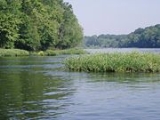
Justicia americana
Encyclopedia
American Water-willow (Justicia americana) is a herbaceous
, aquatic
flowering plant
in the Acanthus family
native to North America
. It is the hardiest species in the genus Justicia
, the other members of which being largely tropical and subtropical, and it is able to survive as far north as USDA zone 4. It is common throughout its range.
The plant grows partially submerged in still or flowing water, reaching up to 40 cm (1 ft. 4 in.) tall from a creeping rhizome
. The leaves
are 10 cm (4 in.), opposite, sessile, linear or lanceolate, and slightly crenulated. The flowers are bicolored, born in opposite arrangement on spikes
3 cm (1 in.) long coming off a peduncle
10 cm (4 in.) long. Color ranges from white to pale lavender with the upper corolla lip pale violet or white, arching over the lower lip mottled in dark purple. The lateral lobe
s are unadorned or slightly blushed. The anthers are purplish-red rather than the usual yellow. Flowering is from May to October. The fruit of this plant is a small brown capsule.
The creeping rhizome allows J. americana to form large colonies on or near the shorelines of still or slow waters in lakes and rivers, and on rocky riffles and shoals in faster flowing rivers. Its rhizomes and roots provide important spawning sites for many fish species and habitat for invertebrates.
Herbaceous
A herbaceous plant is a plant that has leaves and stems that die down at the end of the growing season to the soil level. They have no persistent woody stem above ground...
, aquatic
Aquatic plant
Aquatic plants are plants that have adapted to living in aquatic environments. They are also referred to as hydrophytes or aquatic macrophytes. These plants require special adaptations for living submerged in water, or at the water's surface. Aquatic plants can only grow in water or in soil that is...
flowering plant
Flowering plant
The flowering plants , also known as Angiospermae or Magnoliophyta, are the most diverse group of land plants. Angiosperms are seed-producing plants like the gymnosperms and can be distinguished from the gymnosperms by a series of synapomorphies...
in the Acanthus family
Acanthaceae
The family Acanthaceae is a taxon of dicotyledonous flowering plants containing almost 250 genera and about 2500 species....
native to North America
North America
North America is a continent wholly within the Northern Hemisphere and almost wholly within the Western Hemisphere. It is also considered a northern subcontinent of the Americas...
. It is the hardiest species in the genus Justicia
Justicia
Justicia is a genus of flowering plants in the bear's breeches family, Acanthaceae. The roughly 420 species it contains are native to tropical to warm temperate regions of the Americas, with two species occurring north into cooler temperate regions...
, the other members of which being largely tropical and subtropical, and it is able to survive as far north as USDA zone 4. It is common throughout its range.
The plant grows partially submerged in still or flowing water, reaching up to 40 cm (1 ft. 4 in.) tall from a creeping rhizome
Rhizome
In botany and dendrology, a rhizome is a characteristically horizontal stem of a plant that is usually found underground, often sending out roots and shoots from its nodes...
. The leaves
Leaf
A leaf is an organ of a vascular plant, as defined in botanical terms, and in particular in plant morphology. Foliage is a mass noun that refers to leaves as a feature of plants....
are 10 cm (4 in.), opposite, sessile, linear or lanceolate, and slightly crenulated. The flowers are bicolored, born in opposite arrangement on spikes
Inflorescence
An inflorescence is a group or cluster of flowers arranged on a stem that is composed of a main branch or a complicated arrangement of branches. Strictly, it is the part of the shoot of seed plants where flowers are formed and which is accordingly modified...
3 cm (1 in.) long coming off a peduncle
Peduncle (botany)
In botany, a peduncle is a stem supporting an inflorescence, or after fecundation, an infructescence.The peduncle is a stem, usually green and without leaves, though sometimes colored or supporting small leaves...
10 cm (4 in.) long. Color ranges from white to pale lavender with the upper corolla lip pale violet or white, arching over the lower lip mottled in dark purple. The lateral lobe
Lobe (anatomy)
In anatomy, a lobe is a clear anatomical division or extension that can be determined without the use of a microscope This is in contrast to a lobule, which is a clear division only visible histologically....
s are unadorned or slightly blushed. The anthers are purplish-red rather than the usual yellow. Flowering is from May to October. The fruit of this plant is a small brown capsule.
The creeping rhizome allows J. americana to form large colonies on or near the shorelines of still or slow waters in lakes and rivers, and on rocky riffles and shoals in faster flowing rivers. Its rhizomes and roots provide important spawning sites for many fish species and habitat for invertebrates.

